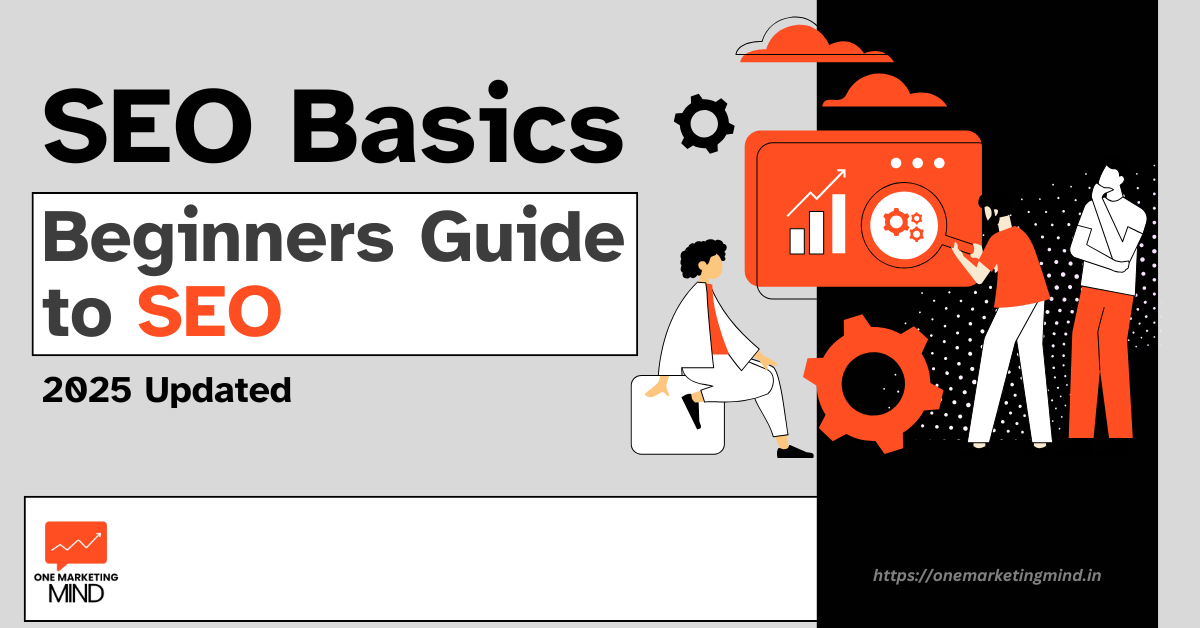SEO, or Search Engine Optimization, is the process of enhancing a website’s visibility on search engines like Google. It involves optimizing various elements to rank higher in search results, driving organic traffic and increasing online presence.
In the vast digital landscape, understanding the intricacies of Search Engine Optimization is paramount for anyone seeking a successful online presence. It is not just a buzzword; it’s the key to unlocking the full potential of your website and reaching the right audience. Let’s delve into the SEO Basics, its importance, and how it shapes the online experience.
Table of Content
What is SEO? (Search Engine Optimization)
SEO is a term that stands for Search engine optimization. In simple words, it is defined as the process of optimizing the website for search engines to get online visibility and ranking on search engine result pages (SERP).
What is the purpose of SEO?
The main purpose of search engine optimization is to improve the ranking of the website and make it more visible to relevant users as per their search queries. The process is the same for all search engines like Google, Bing, Yahoo, and more.
Why Search engine optimizationis So popular?
SEO is one of the most used strategy of Digital marketing. Due to competition in every industry, it is important to keep a top spot to get the attention of the targeted user. So businesses thrive on getting a top rank on search engines Hence, Search engine optimization comes into play. In SEO there are lots of techniques, and with the use of these techniques, we increase the website performance and its quality.
You may also like to read: What is digital marketing? (2025 update)
SEO Basics – Importance of Learning SEO for Beginners in 2025
For beginners, Search engine optimization is a digital compass guiding your content through the vast online landscape. It’s the key to being discovered, attracting your target audience, and establishing a formidable digital presence. Embrace search engine optimization, and watch your online journey transform.
So Why is search engine optimization the most important thing to do for websites nowadays? The answer is lies inside the purpose of the website. Yes, Why do we build websites? For providing essential information to our targeting customers and offering and promoting services.
Hence due to this approach there are many websites trying to reach the top position of Google for the targeted keyword. Look at the following stats and facts the shows how seo is important
Consider the following insightful statistics and facts, illustrating the paramount importance of search engine optimization. These numbers underscore the competitive landscape and showcase how SEO for beginners is not merely an option but an imperative strategy for achieving online visibility and success.
Top SEO statistics and facts for 2025
Here are some informative statistics about Search engine optimization to showcase its importance in real world of marketing.
- Over 70% of clicks on Search Engine Results Pages (SERPs) are garnered by the top five results.
- The initial organic search result boasts an average click-through rate of 27.6%.
- Fewer than 1% of users navigate to the second page of search results.
- A significant 26% of searches concluded with no clicks.
- The algorithm employed by Google encompasses more than 200 factors.
- Google dominates mobile search with an almost 94% market share.
- Yahoo and Bing, with market shares of 3.23% and 3.17%, respectively, rank as the second and third most utilized search engines globally.
- Over the last five years, Google has implemented around 36 significant algorithm updates.
- On average, internet users perform three to four daily searches on search engines.
- The majority of Google traffic originates from the United States, India, and Brazil.
- Experts assert that the pivotal ranking factors in 2023 include quality content, backlinks, and search intent/relevance.
- Google revises titles approximately 61% of the time and descriptions about 63% of the time.
- The average age of top result pages stands at 2.6 years.
- Click-through rates experience an average decline of 32.3% for each position on the first page.
- The top-ranked search results typically have 3.8 times more backlinks than lower-ranked results
According to the above status you may consider how organic search and search engine optimization plays an important role in your website or businesses online presence. Hence, Adapting search engine optimization in your marketing strategy is a winning approach for your business growth. Lets unfold the basics of SEO.
How to Learn SEO from Scratch?
The learning roadmap to seo is the learning its basics first. This may include the from understanding the core concepts to real time scenario of working process. Lets explore some most easiest and ways to learn SEO.
- Enroll in reputable online courses or training programs offered by experts or institutions.
- Utilize free online resources such as blogs, forums, and YouTube tutorials dedicated to SEO learning.
- Practice hands-on by working on personal or small-scale projects, experimenting with different techniques.
- Stay updated with industry news and algorithm changes through following reputable blogs, attending webinars, and participating in communities.
- Analyze and learn from successful case studies to understand real-world applications and strategies.
- Seek mentorship or guidance from experienced professionals through networking events, LinkedIn connections, or professional organizations.
- Constantly test and refine your SEO knowledge through trial and error, adapting strategies based on results and feedback.
- Consider pursuing certifications in SEO to validate your skills and enhance your credibility in the field.
So now we explore the all the essential parts of learning, Continue reading to know each part more briefly
SEO Basics Part 1- Understanding Search Engines and How it work?
Understanding How Search Engine Works?
Search engines act as gatekeepers to the vast realm of information available on the internet. When a user initiates a search, the search engine employs a three-step process: crawling, indexing, and ranking.
- Crawling: Search engines use automated bots, often referred to as spiders or crawlers, to scour the internet for new and updated content. These bots follow links from one page to another, collecting data and indexing it for future retrieval.
- Indexing: The gathered information is then organized and stored in a massive database known as an index. This index enables search engines to quickly retrieve relevant information when a user enters a search query.
- Ranking: When a user initiates a search, the search engine evaluates the indexed pages to determine their relevance to the query. Pages are then ranked based on various factors, such as content quality, relevance, and authority.
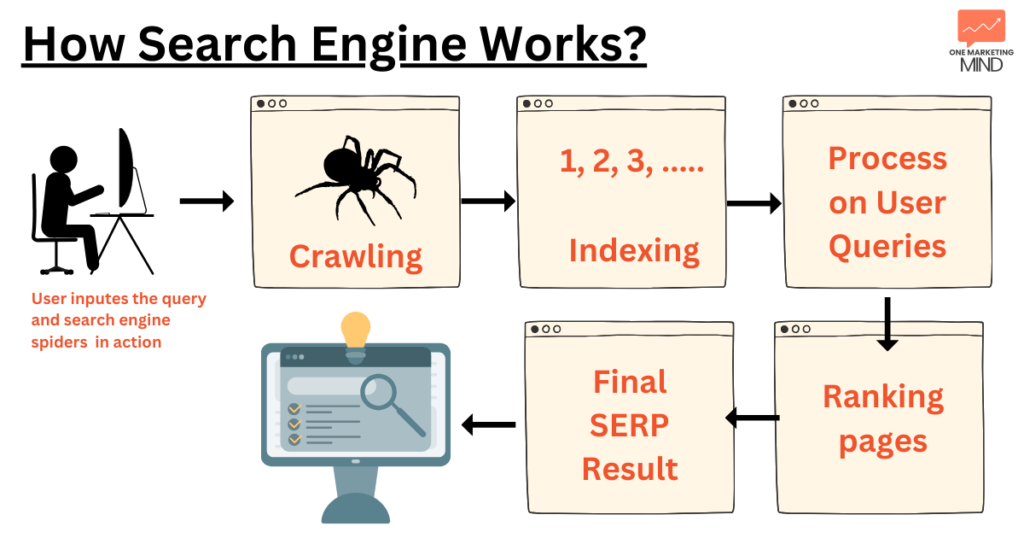
Understanding this process is vital for SEO practitioners as it allows them to optimize content in a way that aligns with search engine algorithms.
Understanding Search engine algorithms
Search engine algorithms act as the guiding stars that determine the visibility of content. From Google’s complex algorithms to Bing’s unique approach, each search engine employs its own set of rules to rank and display search results.
The Significance of Algorithms in SEO
Search Engine Optimization is the heartbeat of online visibility. Algorithms play a pivotal role in SEO, influencing the fate of websites based on factors such as relevance, authority, and user experience. Understanding these factors is paramount to crafting a winning SEO strategy. To know more about how search engine algorithm work please check this guide.
SEO Basics Part 2 – Understanding Types of SEO
If your website is not getting any traffic may be it wouldn’t be optimized for SEO. That means it is divided in 4 major types. It is must to optimize or checked website for these types. Here are the top 4 types of search engine optimization.
- On page Optimization
- Off page Optimization
- Technical SEO
- Local SEO
Now explore each of these types with it important activities.
1. On Page SEO
On-Page SEO encompasses a spectrum of techniques and best practices aimed at optimizing individual web pages for search engines. This optimization occurs within the content and HTML source code of a page, allowing search engines to better understand the page’s relevance to a user’s search query. The goal is to provide a seamless and user-friendly experience while signaling to search engines that the content is valuable and relevant.
Importance of On-Page Optimization
On-page SEO lays the foundation for a well-optimized website. It involves strategic elements that directly impact search engine rankings and user experience.
Types of Onpage SEO (Strategies with example and best practices)
Content Optimization
At the core of On-Page SEO is content optimization. This involves strategically placing relevant keywords within the content, meta titles, and meta descriptions. 🎯 Crafting compelling and informative content that aligns with user intent is crucial.
For example, if the keyword is "digital marketing strategies," incorporating it naturally within the content ensures search engines recognize the page's relevance.
HTML Tags Optimization
Optimizing HTML tags involves fine-tuning elements such as title tags, meta descriptions, and header tags. Title tags should be concise, descriptive, and contain the primary keyword. Meta descriptions provide a brief summary, enticing users to click. Header tags (H1, H2, H3, etc.) structure the content and signal hierarchy to search engines.
Recommended best practice: Use One H1 tag for each webpage.
SEO Friendly URL Structure
A clean and readable URL structure aids both users and search engines in understanding the content hierarchy. Including relevant keywords in the URL improves the page’s SEO.
For instance, a URL like "yourwebsite.com/digital-marketing-strategies" is more SEO-friendly than a generic one.
Image Optimization
Images enhance user experience, but they also need optimization. Using descriptive file names and alt text containing keywords helps search engines understand the image’s context. This not only contributes to optimization but also improves accessibility.
Alt Text: Alt text, or alternative text, is used to describe images on a webpage. In the context of a smoothie recipe digital marketing website, if there's an image of a digital marketing types, the alt text could be "Digital marketing types"
Page Loading Speed
User experience is a significant ranking factor, and page loading speed plays a crucial role. Optimizing images, leveraging browser caching, and minimizing unnecessary scripts contribute to a faster-loading page. This not only improves Search engine optimization but also reduces bounce rates.
Keyword Research and Optimization
Keyword research is the backbone of Search engine optimization. Understanding what your audience is searching for helps you create content that aligns with their needs and interests.
Keyword optimization involves strategically incorporating relevant search terms into your content to enhance visibility on search engines.
Popular Keyword research tools : SEMRUSH, Ahrefs, Google keyword planner For instance, if you're writing about "digital marketing" ensure that this key phrase is seamlessly integrated into your article to attract users searching for that specific topic.
Meta title and Meta Descriptions
Title Tags:
Title tags are HTML elements that define the title of a web page. For a blog post on Digital marketing, a well-optimized title tag could be “Digital marketing: Guide for beginners” It’s both descriptive and contains the primary keyword.
Best practices - Write a catchy title that grab attention and inform user about your topic. Make sure the title written under 60 character, Use numbers or symbols if necessary.
Meta description
Meta descriptions are concise summaries that appear beneath the title in search engine results. Crafting an enticing meta description,
Such as “Explore top digital marketing strategies with examples” not only informs users but also encourages them to click on your link.
Best practices - Write a unique and on point description about pages, It should be under 160 characters. Make sure to add primary keyword in description.
Website Structure
Website structure involves organizing your content in a logical and user-friendly manner.
If your website is about various Digital marketing, create distinct sections for "search engine optimization," "Social media," and "Content marketing" This clear structure not only aids user navigation but also helps search engines understand the thematic organization of your site.
Related read: Advance top 12 On-Page SEO techniques to follow in 2025
2. Off Page SEO
Off page SEO involves to building a authority of website using various techniques. These techniques are creating backlinks for websites and social signals.
What is a backlink?
The backlinks are nothing but the incoming link from the other website to our website, In simple words if other websites or resources are linking to your website from theirs. These Backlinks play a pivotal role in SEO strategies.
The most crucial elements for achieving high rankings on Google for target keywords are content pieces and backlinks, with RankBrain closely following as the next significant factor according to Google.
Creating backlink is also known as Link Building. Let explore more about Backlinks and social signals
How to create Backlinks for websites?
There are four ways you can create backlinks for the website, These 4 ways are as follows
- Add – Manually creating backlinks for website on other relevant websites
- Ask – Asking or reaching out to website owner for linking
- Buy – Buying links from other relevant source and website
- Earn – Getting organic links from the website visitors
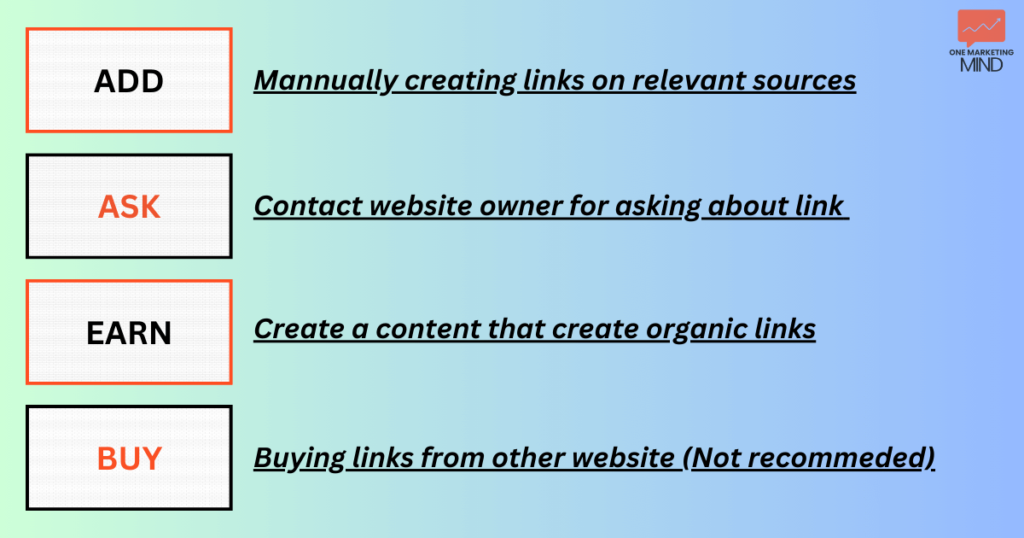
Let’s discuss each shortly.
- Adding Links: In that type, you go to other websites like submission, listing, social sharing, directories, and others to add your website links.
- Asking for the link: In this type of link building, you simply ask for links to website owners of other websites. This link-building tactic is good but needs patience and time. Note: Before asking for a link, you must check the authority of the website and its relevance to your content.
- Buying links: In this type of website, the owner offers money or any compensation for linking to the website.
- Earning Link: This link-building type is mostly recommended and effective. In this way, you can create content that provides value to users, and people will naturally link back to your website. Make sure your content is best-performing and helpful to the user.
Related read: Top Off-Page SEO Techniques
3. Technical SEO
Technical SEO focuses on the infrastructure and backend elements of your website that affect its visibility in search engine results. In this section, we’ll delve into key technical aspects and how they contribute to improving your site’s performance.
1. Website Speed Optimization
Website speed plays a crucial role in user experience and search engine rankings. Slow-loading websites can lead to high bounce rates and decreased user engagement.
- Optimizing website speed involves various factors such as minimizing server response time, leveraging browser caching, and optimizing images and code.
- Consider a user searching for information on their mobile device. If a website takes too long to load, the user is likely to abandon it and seek information elsewhere, resulting in lost traffic and potential conversions.
Important tools: Google page speed insights. GTMetrix, Pingdom, Webpage test, Lighthouse
2. Mobile-Friendliness and Responsive Design:
With the majority of internet users accessing websites via mobile devices, ensuring mobile-friendliness is essential for SEO success.
Responsive web design allows your website to adapt seamlessly to different screen sizes and devices, providing a consistent and user-friendly experience across desktops, smartphones, and tablets.
A website optimized for mobile devices will display content in a readable format without the need for users to zoom in or scroll horizontally. This enhances user satisfaction and encourages longer on-site engagement.
3. Site Security (HTTPS/SSL)
Website security is paramount for protecting user data and maintaining trust. HTTPS encryption is a ranking factor in Google’s algorithm and is now considered a standard practice for all websites.
Implementing HTTPS encrypts data transmitted between the user’s browser and your website, safeguarding it from potential hackers or eavesdroppers.
Imagine a user visiting an e-commerce website to make a purchase. If the site lacks HTTPS encryption, the user may hesitate to enter sensitive payment information, fearing potential security breaches.
4. Schema Markup for Enhanced Search Results
Schema markup is a form of structured data that provides additional context to search engines about the content on your website.
By implementing schema markup, you can enhance your search listings with rich snippets, which may include ratings, reviews, prices, and other relevant information.
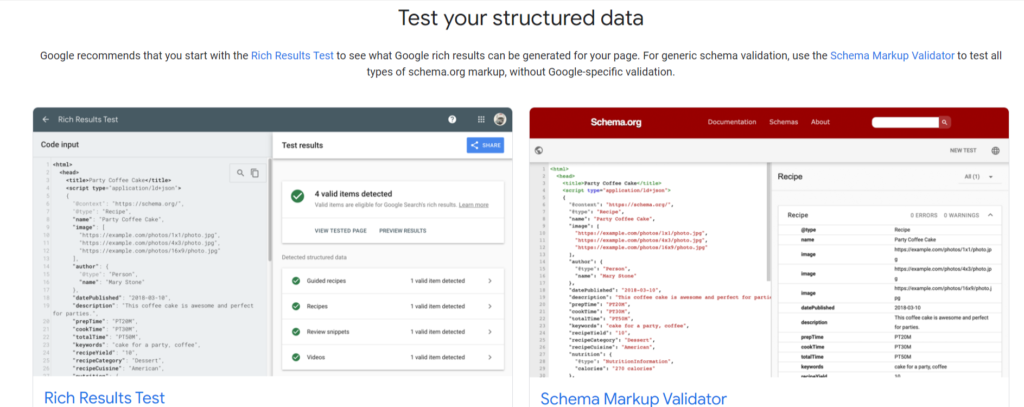
Important note: To find and analyze schema on your website or page you can simply use this free tool Schema Markup Testing Tool
5. Crawling and Indexing
Crawling and indexing are fundamental processes by which search engines discover, analyze, and store information from websites.
- Crawling involves search engine bots systematically browsing the web, following links from one page to another, and gathering data. Indexing is the process of storing and organizing this data in the search engine’s database, making it retrievable for search queries.
- When a search engine crawler visits a webpage, it analyzes the content, follows internal and external links, and indexes relevant information such as keywords, metadata, and page structure. This indexed data is then used to generate search results when users enter related queries.
Important note: To find how many pages indexed or finding indexing status simply Google search site:yourwebsitedomain.com It will shows all the indexed pages within your site on Google
6. XML Sitemaps and robots.txt
XML sitemaps and robots.txt files are essential tools for communicating with search engines and guiding their crawling and indexing processes.
- An XML sitemap lists all the pages on your website, helping search engines discover and index your content more efficiently. The robots.txt file provides instructions to search engine crawlers on which pages to crawl or ignore.
- By submitting an XML sitemap to search engines and properly configuring the robots.txt file, you can ensure that important pages are crawled and indexed while preventing sensitive or duplicate content from being indexed.
Important note: To find sitemap you can search https://yourwebsitedomain.com/sitemap.xml To find robots.txt file - Search https://yourwebsitedomain.com/robots.txt
7. Broken Links
Broken links, also known as dead links or 404 errors, occur when a hyperlink points to a webpage that no longer exists or has been moved.
Broken links negatively impact user experience and Search engine optimization by disrupting navigation and indicating outdated or poorly maintained content. Regularly auditing and fixing broken links is essential for website health.
Important tools to find broken links on your sites - Rankmath plugin, Brokenlinkchecker, Deadlink checker etc
4. Local SEO: Enhancing Your Online Presence Locally
Local SEO is crucial for businesses targeting a specific geographic area. It focuses on optimizing your online presence to attract local customers and improve visibility in local search results. Let’s explore the key components of local SEO:
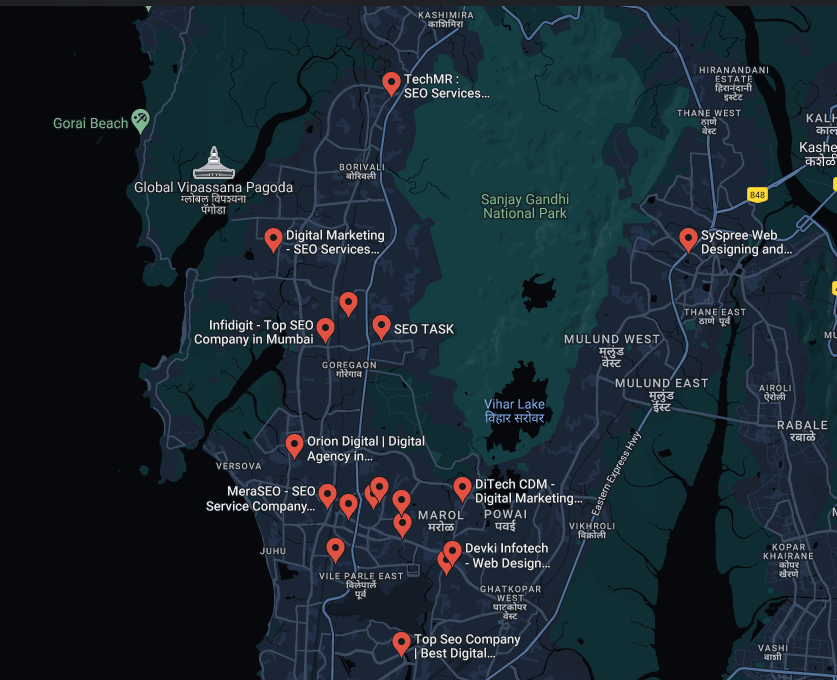
Importance of Local Citations and Directories
Local citations refer to online mentions of your business name, address, and phone number (NAP) on other websites, directories, and platforms. Having consistent and accurate citations across various online sources helps search engines verify the legitimacy and relevance of your business.
Example: If your business is listed on Yelp, Google My Business, and local chamber of commerce directories with consistent NAP information, it signals trustworthiness to search engines and potential customers.
Optimizing Google My Business Profile
Google My Business (GMB) is a powerful tool for managing your business’s online presence on Google, including Google Maps and local search results. Optimizing your GMB profile involves providing detailed and accurate information about your business, such as business hours, categories, services, and photos.
Example: A complete and well-optimized GMB profile increases your chances of appearing in the local "3-pack" or map listings, which prominently feature businesses related to a user's search query.
Local Keyword Targeting
Local keyword targeting involves optimizing your website content, meta tags, and headings to include location-specific keywords relevant to your target audience. Conducting keyword research with a local focus helps you identify terms and phrases that potential customers are using to search for businesses in your area.
Example: If you're a bakery in New York City, optimizing your website for keywords like "best cupcakes in NYC" or "artisanal breads Upper East Side" can attract local search traffic interested in your offerings.
Encouraging Online Reviews and Testimonials
Online reviews and testimonials play a significant role in shaping consumer perceptions and influencing purchase decisions, especially for local businesses. Actively encouraging satisfied customers to leave positive reviews on platforms like Google, Yelp, and Facebook can improve your business’s reputation and credibility.
Example: A local restaurant with glowing reviews and high ratings is more likely to attract diners looking for a memorable dining experience, ultimately driving foot traffic and repeat business.
SEO Basics Part 3 – How to measure and analyze SEO Performance?
Understanding how to measure and analyze your SEO efforts is essential for gauging success, identifying areas for improvement, and making informed decisions to optimize your strategy. In this section, we’ll explore key performance indicators (KPIs) and tools for evaluating SEO performance:
1. Key Performance Indicators (KPIs) in SEO
KPIs are measurable metrics that indicate the effectiveness of your SEO efforts in achieving your business goals.
Common KPIs include organic search traffic, keyword rankings, conversion rates, bounce rates, and backlink quality.
Example: A significant increase in organic search traffic coupled with a higher conversion rate indicates that your strategy is driving targeted traffic and generating valuable leads or sales.
2. Utilizing Google Analytics for Insights
Google Analytics is a powerful tool that provides valuable insights into website traffic, user behavior, and conversion metrics.
Utilize Google Analytics to track organic search traffic, referral sources, user demographics, and engagement metrics.
Example: By analyzing user behavior metrics such as average session duration and pages per session, you can identify high-performing content and areas for improvement on your website.
3. Tracking Keyword Rankings
Keyword rankings indicate where your website appears in search engine results pages (SERPs) for specific search queries.
Use SEO tools like SEMrush, Ahrefs, or Moz to track keyword rankings over time and monitor fluctuations.
Example: Tracking keyword rankings allows you to identify trends, assess the impact of algorithm updates, and refine your content and optimization strategies to improve visibility for target keywords.
4. Monitoring Backlink Profile
Backlinks are links from external websites pointing to your site and are a crucial factor in search engine ranking algorithms.
Regularly monitor your backlink profile using tools like Ahrefs or Majestic to assess the quality, quantity, and relevance of inbound links.
Example: Monitoring backlinks helps you identify opportunities to acquire new backlinks, disavow toxic links, and assess the overall authority and trustworthiness of your website in the eyes of search engines.
SEO Basics Part 4 – Common SEO Mistakes to Avoid
While implementing SEO strategies is crucial for improving your website’s visibility and attracting organic traffic, it’s equally important to steer clear of common pitfalls that can hinder your efforts. In this section, we’ll highlight some prevalent mistakes to avoid
1. Keyword Stuffing
- Keyword stuffing refers to the practice of excessively using target keywords in content, meta tags, or anchor text with the sole intention of manipulating search engine rankings.
- Avoid keyword stuffing as it not only compromises the quality and readability of your content but also violates search engine guidelines, leading to potential penalties.
- Example: Instead of repeatedly inserting keywords unnaturally, focus on creating high-quality, relevant content that naturally incorporates keywords in a way that enhances user experience.
2. Ignoring Mobile Optimization
- With the majority of internet users accessing websites via mobile devices, neglecting mobile optimization can significantly impact user experience and search engine rankings.
- Ensure your website is mobile-friendly and responsive, with fast loading times and easy navigation on smartphones and tablets.
- Example: Test your website’s mobile responsiveness using tools like Google’s page speed insights and prioritize improvements to enhance usability and accessibility across all devices.
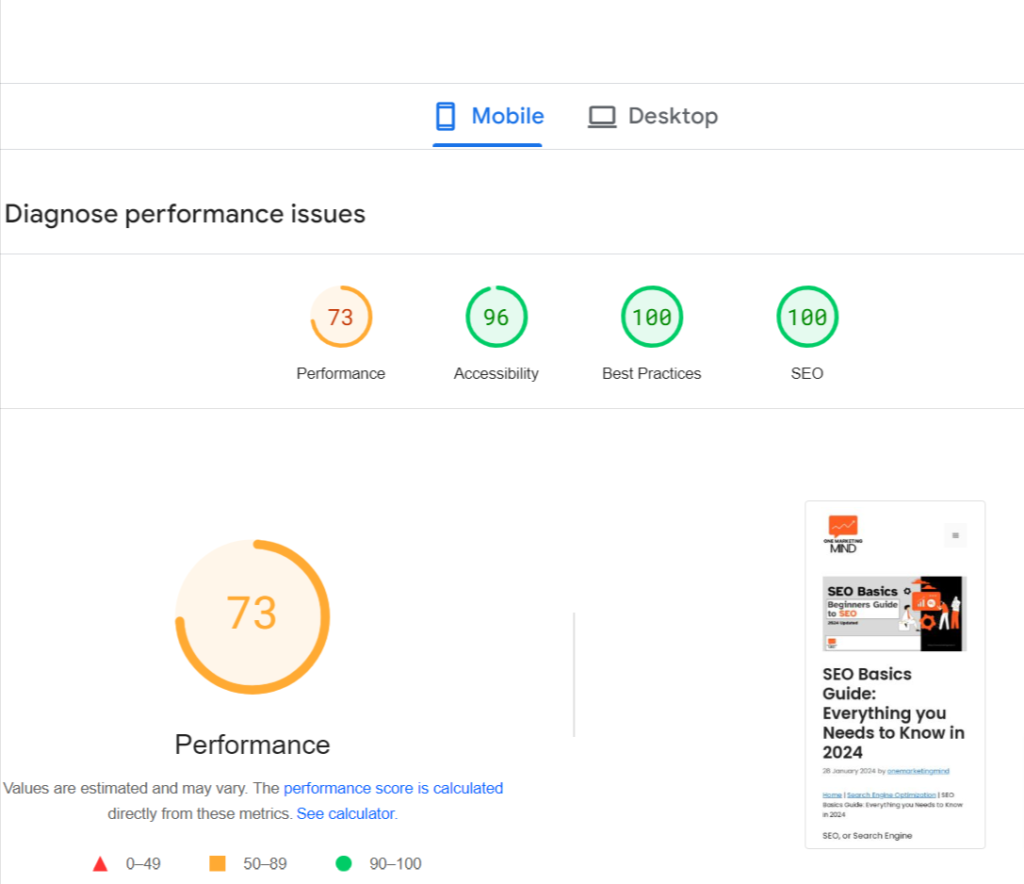
3. Neglecting Technical SEO
- Technical SEO elements such as site speed, crawlability, indexing, and site structure are foundational aspects that directly impact your website’s performance in search engine results.
- Neglecting technical factors can hinder search engine bots’ ability to crawl and index your content effectively, leading to decreased visibility.
- Example: Regularly audit your website for technical issues using tools like Google Search Console and fix errors such as broken links, duplicate content, and crawl errors promptly.
4. Overlooking Content Quality
- Content is at the core of any successful strategy, and overlooking its quality can undermine your efforts to attract and engage users.
- Avoid publishing thin, low-quality content that lacks substance or originality, as it can negatively impact your website’s credibility and authority.
- Example: Invest time and resources in creating valuable, informative, and engaging content that addresses the needs and interests of your target audience, aiming for depth, relevance, and uniqueness.
5. Neglecting Local SEO Opportunities
- For businesses targeting a local audience, neglecting local SEO opportunities such as optimizing Google My Business, local citations, and targeting location-specific keywords can limit visibility and customer reach.
- Take advantage of local SEO tactics to ensure your business appears in local search results and directories, increasing its online visibility and attracting nearby customers.
- Example: Claim and optimize your Google My Business listing with accurate business information, encouraging positive reviews, and leveraging local keyword targeting to enhance local search visibility.
By avoiding these common SEO mistakes and focusing on best practices, you can maximize the effectiveness of your SEO efforts, improve your website’s visibility in search engine results, and drive sustainable organic traffic and conversions.
SEO Basics Part 5 – Future Trends in Search engine optimization
As the digital landscape evolves, staying ahead of emerging trends is crucial for maintaining a competitive edge in the realm of SEO. In this section, we’ll explore some future trends poised to shape the future of search engine optimization:
1. Voice Search Optimization
- With the growing prevalence of voice-enabled devices and virtual assistants like Siri, Alexa, and Google Assistant, voice search is becoming increasingly popular.
- Optimizing content for voice search involves understanding natural language queries, conversational keywords, and providing concise, relevant answers.
- Example: Businesses can adapt their SEO strategies by incorporating long-tail conversational keywords and structuring content in a way that answers common voice search queries directly.
2. Artificial Intelligence and Machine Learning in Search
- Search engines are increasingly leveraging artificial intelligence (AI) and machine learning algorithms to deliver more personalized and relevant search results.
- AI-powered algorithms analyze user behavior, preferences, and context to tailor search results and enhance user experience.
- Example: Google’s RankBrain algorithm uses machine learning to interpret search queries and deliver more accurate and relevant results based on user intent, context, and historical data.
3. The Rise of Video and Visual Search
- Visual content, including images and videos, continues to gain prominence in search engine results pages (SERPs) and user engagement.
- Visual search technology enables users to search for information using images rather than text, opening up new opportunities for discovery and optimization.
- Example: Businesses can optimize visual content by adding descriptive alt text, using relevant keywords in image filenames, and leveraging structured data markup for enhanced visibility in visual search results.
Who Should Know About SEO?
Search Engine Optimization (SEO) is a crucial aspect of digital marketing that benefits various individuals and organizations. Here’s a list of who should know about SEO:
Business Owners
Understanding SEO helps business owners improve their online visibility, attract more customers, and increase sales through organic search.
Marketers
Marketers utilize SEO strategies to enhance their marketing campaigns, drive website traffic, and generate leads for businesses.
Web Developers
Web developers should be familiar with SEO principles to ensure that websites are optimized for search engines, resulting in better rankings and user experience.
Content Creators
Content creators use SEO techniques to create content that ranks well in search engine results pages (SERPs) and reaches a wider audience.
Digital Marketing Professionals
Professionals in the digital marketing field, including SEO specialists, should have in-depth knowledge of SEO to develop effective marketing strategies and campaigns.
Entrepreneurs
Entrepreneurs can benefit from understanding SEO to grow their online presence, build brand authority, and gain a competitive edge in their industry.
Bloggers and Influencers
Bloggers and influencers use SEO to increase their website traffic, attract more followers, and monetize their online platforms effectively.
Students and Job Seekers
Students studying marketing, digital media, or related fields, as well as job seekers in the digital marketing industry, should learn about SEO to enhance their skillset and career prospects.
E-commerce Store Owners
E-commerce store owners rely on SEO to optimize product listings, improve website rankings, and drive sales through search engine traffic.
Anyone with an Online Presence: Whether you’re a freelancer, consultant, or individual with a personal website or social media profile, understanding SEO can help you establish a strong online presence and achieve your goals.
Roadmap for Learning SEO
Let make it simple to recapping the how one can learn seo step by step with a simple roadmap to learning SEO. Here is best practicle approach that anyone can follow in there learning journy
Understand the Basics
- Learn what SEO is and why it is essential for online visibility.
- Familiarize yourself with common SEO terms and concepts.
Website Basics
- Learn how search engines crawl and index websites.
- Understand the importance of website structure and navigation.
Keyword Research
- Explore keyword research tools.
- Identify relevant keywords for your industry or content.
On-Page SEO
- Optimize title tags, meta descriptions, and header tags.
- Understand the importance of keyword placement in content.
Content Creation
- Create high-quality, valuable content for users.
- Understand the principles of content optimization.
Technical SEO
- Learn about website speed and performance optimization.
- Understand the basics of website coding and structure.
Off-Page SEO
- Explore link-building strategies.
- Understand the impact of social signals on SEO.
Local SEO
- Learn how to optimize for local searches.
- Understand the importance of local business listings.
SEO Analytics
- Use tools like Google Analytics to track website performance.
- Monitor key SEO metrics and understand how to interpret data.
Stay Updated
- Follow industry blogs and forums for the latest SEO trends.
- Stay informed about search engine algorithm updates.
Practice and Implement
- Apply your knowledge by optimizing real websites or content.
- Monitor the results of your SEO efforts and make adjustments as needed.
Continuous Learning
- SEO is a dynamic field, so commit to continuous learning and adaptation.
- Attend webinars, workshops, or courses to stay updated with industry changes.
By following above roadmap you can start you SEO learning without ease.
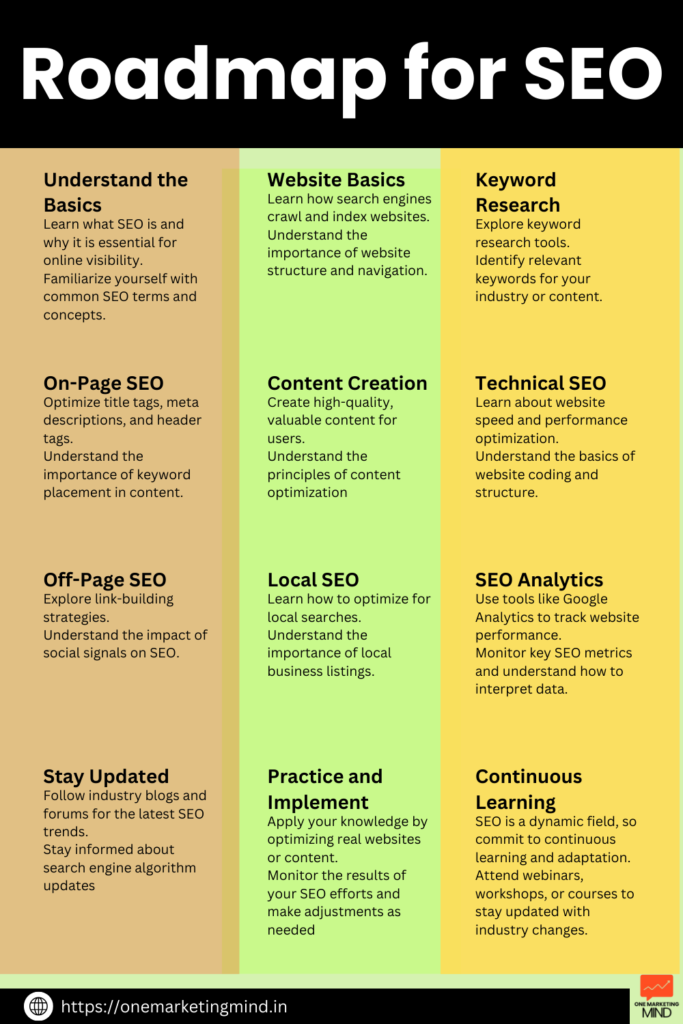
Conclusion
In conclusion with this Search engine optimizations basics guide, while the landscape of Search engine optimization is constantly evolving, the core principles remain steadfast. By staying abreast of emerging trends and adapting to technological advancements, businesses can position themselves for sustained success in the ever-changing digital ecosystem. As we look to the future of Search engine optimization , it’s essential to:
- Maintain a user-centric approach, focusing on providing valuable, relevant content that meets the needs of your target audience.
- Prioritize technical excellence, ensuring your website is optimized for speed, mobile-friendliness, and accessibility.
- Cultivate a strong backlink profile, earning high-quality, authoritative links from reputable sources.
Encouragement for Continuous Learning and Adaptation to Algorithm Updates:
- Search engine optimization is a dynamic field, and staying ahead requires ongoing education, experimentation, and adaptation to algorithm updates and industry shifts.
- Embrace a culture of continuous learning, staying informed about industry and marketing trends, attending conferences, and networking with peers to exchange insights and best practices.
Importance of Patience and Persistence in Search engine optimization Efforts:
- Search engine optimization is a long-term investment, and results may not always be immediate. Patience, persistence, and consistent effort are essential for achieving sustainable growth and success in SEO.
Hope you will get an Idea about SEO basics 2025 and its importance for website. So keep practicing and learning for website improvement and growth. Do keep reading our Digital marketing blog for more such knowledge and advancing your marketing skills.
Frequently asked questions
Why is Keyword Research Important for SEO?
Keyword research is crucial for understanding what terms and phrases your target audience uses when searching online. By integrating relevant keywords into your content, meta tags, and other elements, you can enhance your website’s visibility in search results.
How Does Backlinking Impact SEO?
Backlinks, or incoming links from other websites to yours, are essential for SEO. They act as a vote of confidence, indicating to search engines that your content is valuable. Quality backlinks from authoritative sites can improve your website’s authority and search engine rankings.
What is the Difference Between On-Page and Off-Page SEO?
On-page SEO involves optimizing elements on your website, such as content, meta tags, and images, to improve search visibility. Off-page SEO focuses on external factors like backlinks and social signals that contribute to your site’s overall authority and relevance.
Is SEO a one-time task, or does it require ongoing maintenance?
SEO is not a one-time task but rather an ongoing process. Search engines frequently update their algorithms, user behavior evolves, and competitors adjust their strategies. Continuous optimization, monitoring, and adaptation are necessary to maintain and improve your website’s search visibility over time.
What skills do SEO need?
SEO professionals need a range of skills, including keyword research, content creation, technical optimization, data analysis, and the ability to adapt to algorithm changes.
What are SEO types?
SEO encompasses various types, including on-page, off-page , technical , local SEO, mobile SEO, and e-commerce SEO, each targeting specific aspects of website optimization and visibility.
How to learn SEO basics?
1. Explore top blogs to learn the basics.
2. Watch educational videos on YouTube from experts.
3. Subscribe to reputable SEO newsletters like SEOFOMO.
4. Enroll in free SEO courses on platforms such as Coursera, Simplilearn, HubSpot Academy, and Udemy.
SEO is a process that requires dedication, time, and effort. It’s not necessarily easy, but it’s also not overwhelmingly difficult. By investing in the best resources and learning from reputable sources, you can grasp the fundamentals and strategies. On our blog, we provide comprehensive information on What SEO is, how it work, and cover all the essential components and strategies along with practical tips.

